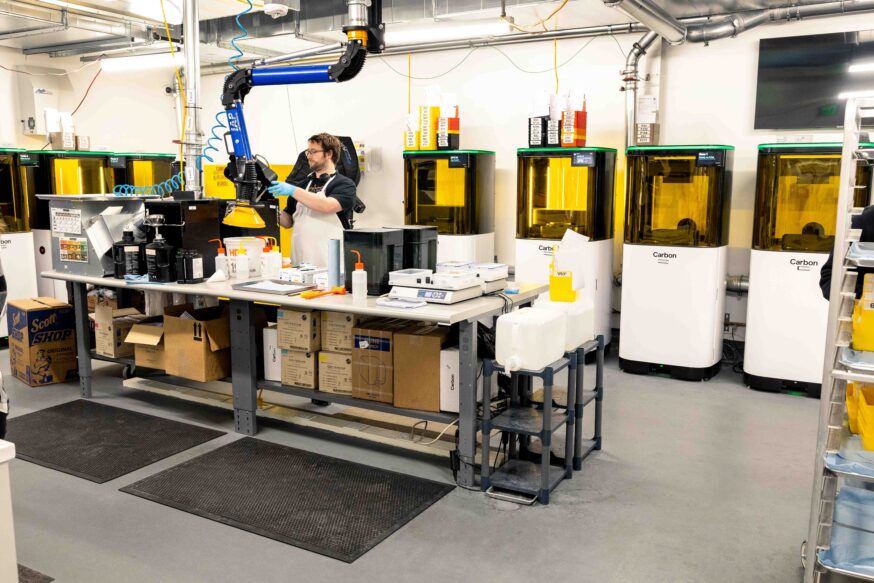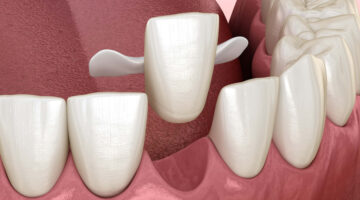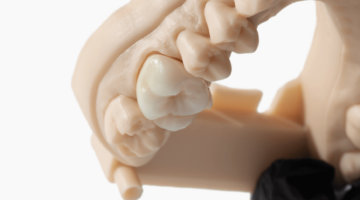Maintaining and operating a dental practice is a long-term project that requires a careful balance of the procedures and methods that have been proven to be best-in-class over years alongside cutting-edge technology. Figuring out how to keep what’s reliable and proven while still keeping an eye to the future of the industry can be tricky. For example: what should dentists do regarding the emergence of 3D printing in the industry? Is the technology sufficiently advanced enough to provide savings and cost-cutting with enough margin to justify the expense? Is the technology as reliable as the time-tested methods of making molds, crowns or other dental appliances and prosthetics?
Nascent but growing, 3D printing is used minimally, but effectively: only 16% of dentists use 3D printing in-office, but an equal amount plan to in the future. Of this group, 2/3 have added the tech in the last two years, and 3D printing is used in at least 25% of their cases—mainly for diagnostic models, but also splits, occlusal devices, and surgical guides. As with many new technologies, younger dentists are claiming the role of early adopter, but increasingly we’re also finding efficiencies in larger offices and especially labs like Dandy’s, where the 3D printing saves significant time at scale. As you explore 3D printing do consider leaving it to the experts at the lab, Doc, you have so many other duties on your plate—running a 3D printing operation further takes you away from your time with patients.
3D printing technology itself is almost 40 years old, and has been used to make everything from fuselages and boat hulls to chess pieces and action figures. For dentistry, it’s most often used to create diagnostic models. Digital dentistry can save a practice the cost and time sink of sending away physical molds to get models, and more sophisticated printers can even be used to fabricate aligners, 3D printed dentures, and crowns. With CAD/CAM technology and intraoral scanning, a level of precision is possible that can even help long-term results and fit. It’s also easier than ever to access 3D printing technology, especially with the help of platforms and services willing to take the heavy lift of digital dentistry off your plate.
What is the process for 3D printing in dentistry?
To start, 3D printing requires a digital model of a patient’s mouth. This starts with an intraoral scan. Simple, faster, and less invasive than impressions, intraoral scans quickly take digital readings and measurements of a patient’s bite so that a dental lab can work off of a 3D model. And unlike with traditional dental impressions, digital files can be sent instantly, not requiring shipping and long wait times, or return visits from patients if something goes wrong. Once your lab receives your scan(s), they can move on to the CAD/CAM part, and model the implants and other parts that will be 3D printed.
What is dental 3D printing used for?
Surgical Guides
More than half of the clinicians using this tech are currently 3D printing surgical guides. Surgical guides are exactly what they sound like—devices that help a dentist understand diagnosis and observe available to create safer and more predictable surgical procedures. Whether you’re an implant specialist or just a general dentist hoping to expand your offering, surgical guides improve clinical outcomes. Lab-printed surgical guides aid technicians with placing implants and lining up prosthetics with with the preferred, least invasive angles and chamfers, giving not just medically sound but aesthetically sound results. They also ensure that surgery is causing less damage and trauma to soft tissue and the surrounding mouth.
Digital dentures
Another popular 3D printed dental offering is minimal-appointment dentures (yes, with Dandy 2-Appointment Dentures are possible). Dentures can be challenging, complex and time-consuming to fit and finish, but with a full denture design team, CAD/CAM tech and 3D printing, you can see patients less and get to happy smiles sooner.
The digital denture process for 3D printing involves an extraoral scan of existing appliance(s) and an intraoral scan of a patient’s it. Then—you guessed it—a lab of experts designs an appliance with the latest custom design libraries and sent to 3D printers to be fabricated with modern, state-of-the-art resins. 3D printed denture patients end up with the perfect, modern convergence of aesthetics and strength—not to mention long-lasting durability. The denture is fully milled and provides the most realistic gumline and is highly aesthetic.
Digital dental models
Of course, the aforementioned prosthetics traditionally requires dentist to take physical PVS mold impressions. This mean mouthfuls of gagging, uncomfortable alginate that could potentially be flavored with grape or bubble gum, but never quite delivered a satisfying experience for the average patient. For decades this mold has helped capture tooth shape, spacing, and alignment. The mold then was the basis for dental workflow, allowing dentists and orthodontists to use this physical replica to model restorations, appliances, and prosthodontic treatments.
And of course these impressions were error-prone. They could contain human error and need to be retaken or recast. The process itself was laborious and time-consuming, and then physical models needed to be physically shipped to and from the various labs that service dental practices. Beyond this, the physical molds take up physical space, and so they need to be stored somewhere! Ask your dentist or dentist friends if they’ve ever had a storage unit…
Digital dental models were designed to help solve almost all of these problems. Intraoral scanners are fast, meaning less chair time for patients. They are precise, meaning fewer re-dos. In less than a minute, a dentist can get a full model of a patient’s mouth, and then in the time it takes to upload the perfect digital 3D impression, that crucial information and model are already at the dental lab. No mailing, no waiting.
By improving patient experience, you also can potentially attract new patients to your dental practice. There are few places people hate waiting like they dislike a wait at their doctor or dentist, and using modern technology to eliminate both discomfort in the chair and the discomfort of waiting is sure to improve many parts of your practice.
Night Guards
One last useful prosthetic device that is also on offer with the magic of 3D printing is the night guard. Designed to help alleviate the tooth and crown damage (as well as general discomfort) caused by bruxism during sleep, night guards can also help with TMD or sleep apnea, depending on the patient.
A good occlusal guard is an insurance policy against damaging your shiny new crowns and bridges, so 3D printing a night guard to match a digital scan of a mouth is simple, and a no-brainer.
Dandy’s 3D printed night guards are exceptionally strong and durable, because they’re made from one piece, opposed to traditional dual-laminate night guards. Fit is next to perfect because of digital scanning, and customization is easy to arrange during the design process, always ensuring a flexible, comfortable fit—you’re wearing it while you’re trying to sleep, after all. It’s all one more easy way to increase your offerings with little lift, all because of the brilliance of CAD/CAM technology and its integration with practices ready to embrace the wider array of easy options and offering with 3D printing.
Dental 3D printing materials and in-office setup
Okay, so you’re convinced. 3D printing is the future of dentistry and you’re on board. Now what? What do you need, and what does your setup look like?
Well, it’s easier to print, but you might not want to do it yourself, which is why letting a digital lab like Dandy take care of 3D printing for you is a solid option. You can get all the benefits of a digital lab without sacrificing counter space, having to train staff to use 3D printers, having to buy, store, and restock resin and other materials, install ventilation, and get new certifications. The all-in cost on a full suite of just the equipment you need to get started is in the neighborhood of $20,000. Recurring costs like resin can be as much as $500.
Plus, all the time and labor saving you get by using a remote digital lab, you might not get if you do-it-yourself. For example, a standard process involves mixing resin (5 minutes), models designed (15 minutes for someone with experience, but with a steep learning curve), cleaning a resin tank (5-20 minutes), printing (10-30), followed by washing and curing. And then machines must receive maintenance. Oh, and you need to properly dispose of the waste. The time and effort savings you get are achieved by sending your models to labs, because the process outlined here only makes sense in large, multi-office practices with dedicated technicians. The good thing? Dandy’s ready to help you out.
Getting better patient outcomes using dental 3D printing
So once you’ve decided to go with a digital dental lab like Dandy or print yourself, how does this really help turnaround times?
With a digital lab relationship, you get all the results of intraoral scanning and 3D printing without sacrificing a second of your workforce’s time to attend to lab procedures. They scan, send, and move on to the next task. Your patients will be happier with less chair time and no modeling gunk in their mouths, but they also will receive care from much less overtaxed and overworked, multitasking staff, as the hard work of lab work will be done elsewhere, by your wonderful friends and compatriots at Dandy. Throwing in more accuracy and precision to the models themselves feels like a bonus on your bonus—but nevertheless, almost better in every way.
When is 3D printing used in dentistry?
Whether you’re investing in your own 3D printer or picking a dental lab to partner with for your practice, the benefits are clear: it’s easier, cheaper, less time consuming, more comfortable for patients, less taxing for staff, and provides better clinical, medical, and aesthetic results.
Being able to offer simply made, perfect-fitting 3D printed night guards as well as precise crowns, dentures, and bridges gives your practice a leg up that you’ll be proud you took. You’ll see happy patients with happier results, and a patient satisfaction that may very well lead to more business over time, in addition to a more streamlined workflow. Learn more about partnering with Dandy as your digital lab and reach out to us today!



